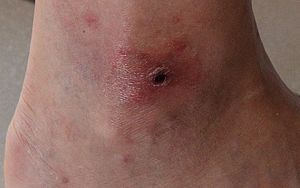African tick-bite fever
| African tick bite fever | |
|---|---|
 |
|
| Leg lesion after Rickettsia africae infection | |
| Classification and external resources | |
| Specialty | Infectious disease |
| ICD-10 | A77.8 |
African tick bite fever (ATBF) is a disease caused by the bacterium Rickettsia africae in sub-Saharan Africa and the West Indies. The bacterium is transmitted to humans by ticks in the Amblyomma genus. African tick bite fever is a type of spotted fever. Symptoms are not always present. Symptoms may include a fever, headache, rash and dead tissue at bite sites. These generally occur within 4–10 days of a tick bite. The clinical symptoms are typically mild and resolve within 3 weeks. Severe complications are very rare.
The diagnosis of African tick bite fever is often based on symptoms. Definitive diagnosis is made by culture, PCR, or immunofluorescence. Data about the appropriate treatment of African tick bite fever is limited. Symptoms tend to be mild and often resolve on their own. However, when people seek medical treatment, physicians may treat the infection with antibiotics used to treat other rickettsial infections, such as Rocky Mountain spotted fever.
African tick bite fever is often asymptomatic or mild in clinical presentation and complications are rare. The onset of illness is typically 5–7 days after a tick bite though the range of symptom onset is 4–10 days. Symptoms can persist for several days to up to three weeks. Common presenting symptoms include:
Complications are rare and are not life-threatening. No deaths due to African tick bite fever have been reported. Reported complications include:
Rickettsia africae is a gram-negative, obligate intracellular, pleomorphic bacterium. It belongs to the Rickettsia genus, which includes many bacterial species that are transmitted to humans by arthropods.
In Sub-Saharan Africa, the most common vectors of R. africae are two species of hard ticks, Amblyomma variegatum and Amblyomma hebraeum. Other species of Amblyomma in sub-Saharan Africa can also transmit R. africae and it may be that up to 100% of Amblyomma ticks in sub-Saharan Africa carry R. africae.Amblyomma ticks are most active from November to April. These tick species frequently feed on cattle and other livestock, but can also be found feeding on wild animals in areas where farm animals are not found. Unlike other hard tick species, which passively seek hosts, the Amblyomma hard ticks actively seek out hosts. These ticks are known to be more aggressive, and several ticks may attack at once, leading to clusters of African tick bite fever cases within groups of persons traveling or working together.
...
Wikipedia
